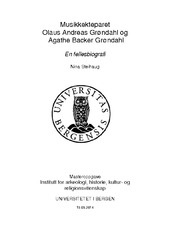Musikkekteparet Olaus Andreas Grøndahl og Agathe Backer Grøndahl. En fellesbiografi
Master thesis
Permanent lenke
https://hdl.handle.net/1956/8399Utgivelsesdato
2014-05-15Metadata
Vis full innførselSammendrag
Sammendrag Tittelen på avhandlingen er: Musikkekteparet Olaus Andreas Grøndahl og Agathe Backer Grøndahl og . En kollektiv biografi. Temaet er ekteskapet mellom Agathe Backer Grøndahl (1847-1907) og Olaus Andreas Grøndahl (1847-1923) (også kjent som O. A. Grøndahl og Olam Grøndahl) fra Kristiania. Paret giftet seg i 1875, og begge var fremtredende musikere på slutten av 1800-tallet. Agathe Backer Grøndahl var en berømt pianist med en internasjonal karriere, en produktiv komponist og klaverpedagog for en ny generasjon av profesjonelle pianister. Olam Grøndahl begynte sin musikalske karriere som sanger og komponist, men fortsatte som dirigent for de fleste av hovedstadens kor, var sanginstruktør på mange skoler, og ble utnevnt av departementet til å utarbeide planer for sang- og musikkundervisning i Norge. Paret bodde i Kristiania, hadde tre barn, deltok svært aktivt i tidens musikkliv, men reiste også mye, på turnéer i inn- og utland. Hovedproblemstillingen i oppgaven er hvordan en gift kvinne i slutten av 1800-tallet kunne bli en profesjonell musiker, en offentlig person og tjene til husholdningen ved sitt yrke. I henhold til tidens ekteskapsideologi var det mannens oppgave å opptre i offentligheten og forsørge sin familie. Kvinnens rolle var i privatlivet og hun skulle være underlagt mannen i ekteskapet. Slik var samtidens ekteskapsideologi. Agathe var verken henvist til hjemmets private sfære eller underlagt sin ektemann. Hun fikk utøve sitt yrke som pianist, komponist og lærer i offentligheten. For en kvinne å være en profesjonell musiker brøt på den tiden samfunnets norm. Det er fire parter som kan forklare dette: kvinnen selv, hennes ektefelle, deres familier og samfunnet. Et mulig svar kan være at de begge fikk et stort talent og en tidlig musikalsk kall. De ble finansiert av sine familier til å reise utenlands for å få en profesjonell utdanning. Da de returnerte til Kristiania, ble begge oppmuntret av familier og publikum til fortsatt følge sitt kall og fortsette sin musikalske karriere. Det synes som "alle" forventet at paret skulle virkeliggjøre sitt musikalske potensial, samtidig som de levde i et konvensjonelt ekteskap. Da de giftet seg 26 år gamle var deres felles kall grunnlaget for ekteskapet. Oppgaven er skrevet som en kildebasert kollektiv biografi Av spesiell interesse er nye kilder som er gjort tilgjengelig for forskning, et stort antall brev som nå er undersøkt og som har gitt verdifull kunnskap om ekteparets siste leveår. Summary The title of the thesis is: A Marriage of Musicians. Olaus Andreas Grøndahl og Agathe Backer Grøndahl. A Collective Biography. The theme of the thesis is the marriage of Agathe Backer Grøndahl (1847-1907) and Olaus Andreas Grøndahl (1847-1923) (also known as O. A. Grøndahl and Olam Grøndahl) of Kristiania in Norway. The couple were married in 1875 and both were prominent musicians during the second half of the 19th century. Agathe was a famous pianist with an international career, a prolific composer of piano and songs and a teacher of a new generation of Norwegian professional pianists. Olam started his musical career as a singer, a tenor soloist, and composer, but later acted as a choir master and conductor of several male and mixed choirs and served as a music teacher at numerous schools. He also participated in the development of the music teaching in Norway, acting for the Government, at the time of the formation of the new national state. The couple lived in Kristiania, had three children and led a comparatively quiet home life, but travelled extensively at times, mostly on separate musical tours. The problem addressed is how a married woman by the end of the 19th century could be a professional musician, a public figure and earn her own money for the support of the family, take her space in the public sphere as an extremely popular concert pianist and at the same time being a conventional upper society housewife. For a woman to be a professional musician was at the time contrary to the ideologies that stated that married women should stay within the private sphere of the family home, and that employment outside the home for family support was the sole responsibility of the husband. There are four parts that may explain how this was possible: the woman herself, her spouse, their families and the musical society. A possible answer might be that the couple both had a large talent and an early musical calling. They were funded by their families to go abroad to get the best education that was available. When they returned to Kristiania, they were encouraged by the families and the public to fulfil their calling and pursue their musical careers. Both partners were supposed to and expected to realise their musical potential, as well as to be a conventional married couple. When they married at the age of 26 this common musical calling was the basis for their marriage The major part of the thesis is a collective biography, both of their individual careers and their joint married life, from their births to their deaths, their careers, their life and family. Of special interest is the new resource material that for the first time has been made available for research. This material consists of large number of letters and these have been examined and given valuable information of the private life of the couple in their later years.
